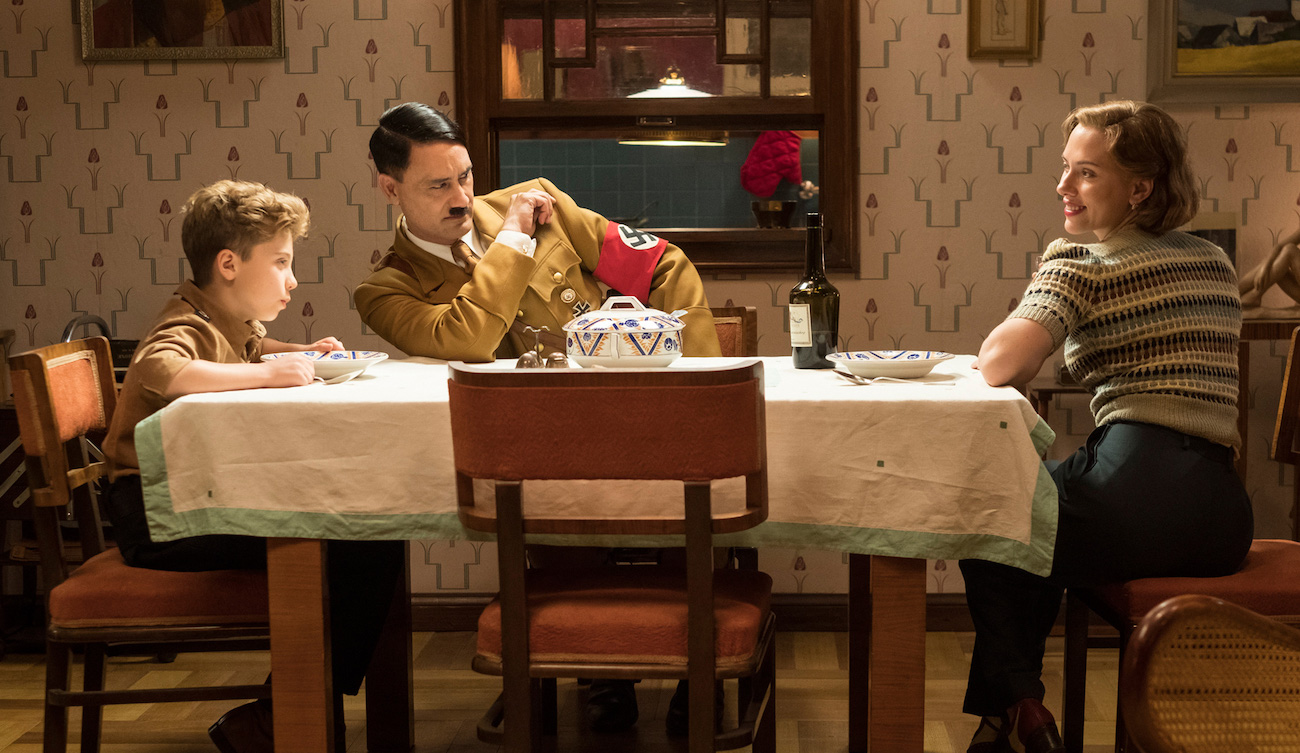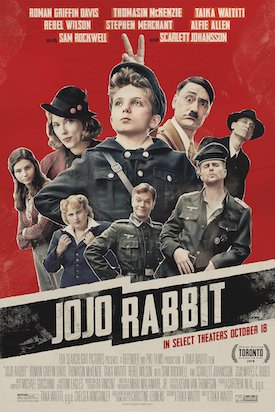 Writer/director Taika Waititi (Thor: Ragnarok, Hunt for the Wilderpeople) brings his signature style of humor and pathos to his latest film, Jojo Rabbit, a World War II satire that follows a lonely German boy (Roman Griffin Davis as Jojo) whose world view is turned upside down when he discovers his single mother, Rosie (Scarlett Johansson), is hiding a young Jewish girl named Elsa (Thomasin McKenzie) in their attic. Aided only by his idiotic imaginary friend, Adolf Hitler (Taika Waititi), Jojo is forced to confront his blind nationalism. The film offers a funny yet profoundly moving child’s-eye view of a society gone mad with intolerance. Drawing on his own Jewish heritage and his experiences growing up surrounded by prejudice, New Zealand filmmaker Waititi (whose mother is Jewish and father is Māori) makes a powerful statement against hate with this pitch-black satire of the Nazi culture that gripped the German psyche at the height of World War II.
Writer/director Taika Waititi (Thor: Ragnarok, Hunt for the Wilderpeople) brings his signature style of humor and pathos to his latest film, Jojo Rabbit, a World War II satire that follows a lonely German boy (Roman Griffin Davis as Jojo) whose world view is turned upside down when he discovers his single mother, Rosie (Scarlett Johansson), is hiding a young Jewish girl named Elsa (Thomasin McKenzie) in their attic. Aided only by his idiotic imaginary friend, Adolf Hitler (Taika Waititi), Jojo is forced to confront his blind nationalism. The film offers a funny yet profoundly moving child’s-eye view of a society gone mad with intolerance. Drawing on his own Jewish heritage and his experiences growing up surrounded by prejudice, New Zealand filmmaker Waititi (whose mother is Jewish and father is Māori) makes a powerful statement against hate with this pitch-black satire of the Nazi culture that gripped the German psyche at the height of World War II.
I admit I am not a big fan of films like Life Is Beautiful that have attempted to bring fantasy or whimsy to stories of World War II, so I was nervous going into this film, and yet I loved every second of it. I thought that Waititi and his team achieved the perfect balance between the fantasy elements of the film and the stark reality of the situation. As one critic said, “It shouldn’t work…but it does!” Based on the book Caging Skies by Christine Leunens, Jojo Rabbit, winner of the People’s Choice Award at this year’s Toronto International Film Festival, also stars Sam Rockwell, Stephen Merchant, Alfie Allen, and Rebel Wilson. I sat down with several of the incredibly talented people who helped create the unique look of the film: production designer Ra Vincent, Visual Effects Supervisor Jason Chen, Makeup and Hair Designer Dannelle Satherley, and film editor Tom Eagles.
Danny Miller: The details in the sets were just stunning. Did you recreate this German village from scratch or did you find real settings that you could adapt for the story?
Ra Vincent: We had done so much research about this time period and did our breakdowns of what we needed, but it wasn’t until we found our locations in the Czech Republic that this world we were creating really expanded. The borders during the Nazi occupation were constantly shifting and the Baroque village we found in the Czech Republic had become a German territory during the war. We even found out that there had been Nazi rallies in some of our locations. It was exactly the aesthetic we needed.
Given the history in that part of the world, was it a bit dicey to bring in all of the swastika flags and banners that you needed for the story?
Ra Vincent: Yes, it was. We had some early discussion about swastikas with the studio, they were very nervous about it, but in the end we decided to do what we wanted. We felt we needed the swastikas or the story and the satire would not work at all. The idea was to confront hate and how that regime was formed. We could not remove the importance of that insignia.
Jason Chen: The swastikas had so much weight in that town. I remember when we were shooting in the building that we were using as Gestapo headquarters and had to put up swastika banners. We actually had several local crew members who told us they couldn’t go in there because their family members had been tortured or killed by the Nazis. The weight our locations carried was a good reminder to us about the message we were trying to convey.
Dannelle, speaking of historical sensitivity, you will now always be able to say that you did Hitler’s hair and makeup. What was that like?
Dannelle Satherley: (Laughs.) Well, with Taika’s character, he was an imaginary version of Hitler as seen through Jojo’s eyes, so we were going for something more roughly hewn than you might see elsewhere. Sure, we had to have the touchstones that everyone knows like the moustache and the combover, but he was never intended to be a carbon copy.
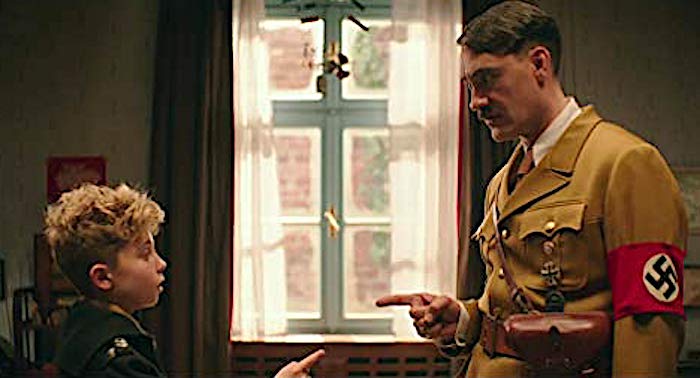
Were there times when Taika was directing in full Hitler drag?
Dannelle Satherley: Oh yes, many times! It was definitely something to see.
I’m sure the on-set jokes were writing themselves: “Help! Our director is Hitler!” Tom, I imagine for a film with such serious themes with comedic elements, finding the exact rhythm in the editing was everything. How difficult it was to maintain that balance?
Tom Eagles: It helped that Taika’s script was amazing. There were differences in the details but we were faithful to the feeling of the script, trying to walk that tightrope between black humor and real emotion throughout.
Were there a lot of clues in the script about how everything should look?
Ra Vincent: Absolutely. Taika’s writing is so good and there were many clues about the characters in the script that you could pull from about what type of environment they would be inhabiting. For production design, it pays not to overstate things, you don’t want to detract from the performance. But, for example, knowing how artistic Rosie (Johansson) was, we added all sorts of nuances in the decoration of the house which also played into Jojo’s view of the world through somewhat rose-colored glasses.
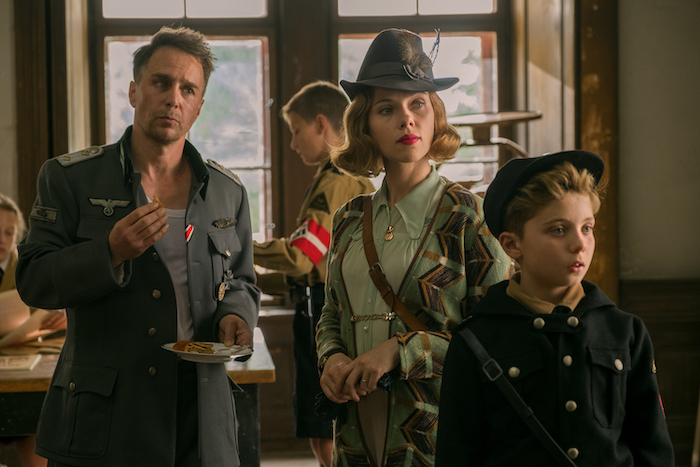
I want to see the film again just to more closely examine all of the delicious details of that house!
I was working with a wonderful set decorator, Nora Sopková, who has been working in Prague for a very long time and she knew where to find all the best things. I like to provide as much realism for the actors as possible. If you’re going to put food on the table in front of them you make it really nice to eat, you fill the drawers with clothes of the period in case they open one during a scene, you add all these authentic touches so there’s an opportunity for bits of spontaneous characterization.
I know in many of Taika’s projects there’s a lot of improv. Was that a worry when trying to maintain the right tone in this story?
Tom Eagles: There were very different types of scenes in this film. For a dramatic scene between Scarlett and Thomasin, for example, they would run through it normally, get some direction, and then perhaps try a few new things when they did it again, but it was a very traditional process. They were amazing actors working with an amazing script. But with our comedians it was something else entirely. They’d constantly be stopping and throwing something new in. It did make it a challenge to keep the rhythm right.
I’m guessing that someone like Rebel Wilson went to town on her takes.
Tom Eagles: Oh, trust me we could definitely do a short film of just alternate takes from Rebel, Stephen Merchant, and Taika as Hitler. And you’d be screaming with laughter! Taika always encouraged them. Whether it was even his intention to use those takes or not, he really wanted these comedians to feel free to explore their characters. A lot of great stuff ended up on the cutting room floor because it just didn’t work with the overall film but we did get some gems that we used.
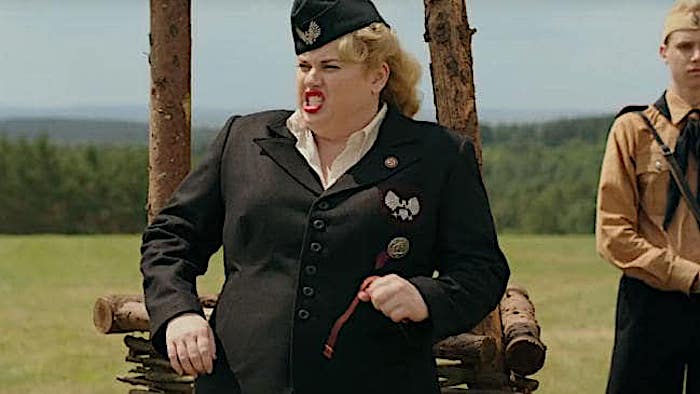
Dannelle, it looked like you were also able to go a bit above and beyond with Rebel’s look, too. Kind of an “Ilsa, She-Wolf of the SS” aesthetic?
Dannelle Satherley: Oh, we had so much fun with Rebel and some other people in the supporting cast because we were able to go a little extra with them. I loved working on Rebel’s hair because we were really able to go to extremes with the look. She carried it so well! But some of the other characters were much more tame. I’ve worked so closely with Taiki over the years that I’m very familiar with his aesthetic. I know, with the possible exception of Thor which was kind of its own world, that Taika errs on the side of naturalism, he doesn’t like anything to look too overcooked.
The extensive research you all did for this project must have been so fascinating.
Jason Chen: I think that’s the best part of what we do. We really did a deep dive on the Hitler Youth. And a lot of the ridiculous things you do see the characters doing in the Hilter Youth camps were actually things that happened, like four- and five-year-old boys roughhousing with teenagers, punching and tackling each other, it was insane. They were completely brainwashed about what they were told would make them good soldiers.
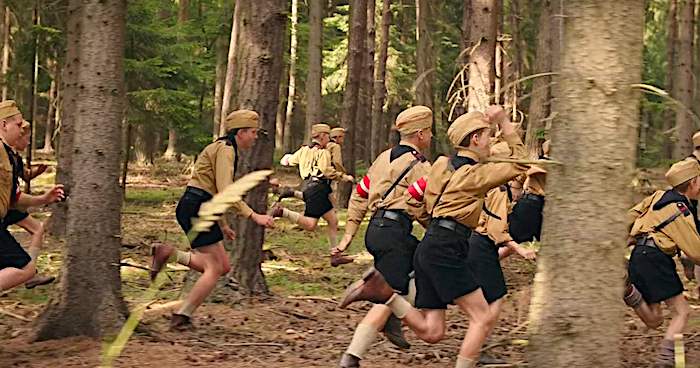
I also really liked the color palette of the film which seemed different from so many films we see set during World War II.
Jason Chen: It’s true. Movies set in this time period are usually very dark and dreary, but the reality of the situation was that towards the end of the war a lot of people dressed to the nines as best they could, they didn’t know how much longer they’d be around. So Taika really wanted a bright and vibrant color scheme throughout.
Ra Vincent: And because this was a story from a child’s perspective, that included us injecting some whimsy and childishness into it. We used a few tricks, even things like having more cars in the background than would necessarily have been around during that point in the war.
To be honest, I was kind of surprised when I first saw the poster for the film because it seems so focused on the comedy whereas I see it as more as a very serious movie with some comedy in it.
Jason Chen: I agree with you, actually, and yet I think Taika’s instinct to lead with the comedy makes a lot of sense so I can see why that’s a big part of the ad campaign. Taika believes that humor kind of loosens people up and makes them open to things that they might not have been otherwise. You’ll notice that the film is quite heavy with comedy in the first act and then that eventually transitions in a big way.

